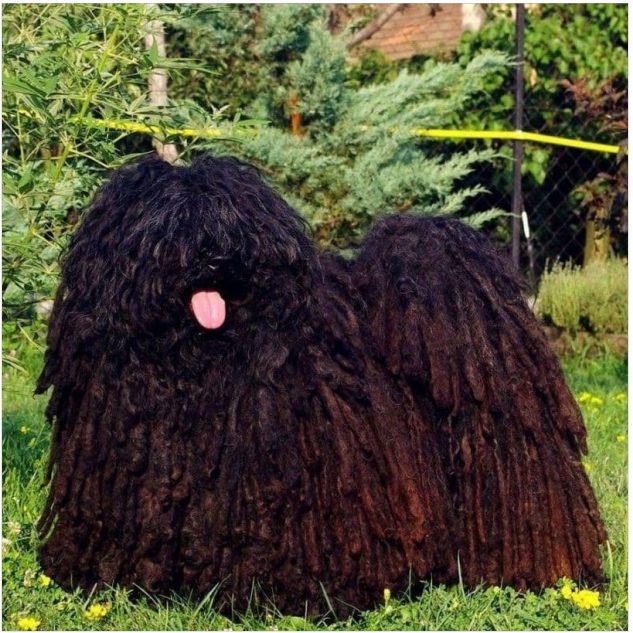
Puli
The Puli is a handsome, compact dog that was originally bred to herd sheep in Hungary, where the breed originates from. It can be hard to see under all that hair, but the Puli is very athletic, as befits a herding dog. Of course the Puli’s stunning dreadlocked coat is perhaps the breed’s most unique feature. Puppies aren’t actually born with dreadlocks, but with crimped fur. As the dog grows up, the cords form. Although black is the most typical coat colour, the Puli’s coat can also be grey, cream, or white. Even adult Pulis are playful and vivacious, and they make brilliant family pets – if you are willing to give them the training and exercise they need. They are often suspicious of strangers, though not usually aggressive.
Puli breed attributes
About Puli breed
Description
The Puli breed is handsome, compact and was originally bred to herd sheep in Hungary, where the breed originates from. It can be hard to see under all that hair, but the Puli is very athletic, as befits a herding dog. The breed has a compact, square build, with a deep chest and strong back. The Puli’s eyes are almond shaped, and the ears a floppy and quite large. The tail is carried up over the back, though it is hard to distinguish from the body under all the corded fur.
Origin: Hungary
Look
Of course the Puli’s stunning dreadlocked coat is perhaps the breed’s most unique feature. Puppies aren’t actually born with dreadlocks, but with crimped fur. As the dog grows up, the cords form. These cords are actually a kind of fur matting, but this matting is controlled. Although the Puli hardly sheds, their coats do require specialised care, and you’ll need to find a dog groomer who is familiar with caring for corded fur. Some owners do prefer to shave their Pulis, but if you want to show your dog, cords are a must.
Although black is the most typical coat colour, the Puli’s coat can also be grey, cream, or white. Some cream dogs also have a black mask marking. The paw pads, nose, and even the inside of the mouth are usually dark.
Health
While the Hungarian Puli is generally healthy and hardy, the breed is prone to a few health conditions:
• Hip Dysplasia
• Progressive Retinal Atrophy (PRA)
• Cataracts
At Newdoggy.com, we promote puppies from reputable breeders, who use genetic testing and good breeding practices to remove genetic conditions from their breeding lines. Newdoggy.com’s Health Guarantee certifies that all promoted puppies are in good health.
Learning
Like many herding breeds, the Puli is very clever and lively. Although the Puli is capable of learning many different commands, they are easily bored by repetitive training. Your Puli will thrive with plenty of exercise and interesting training. Pulis can be stubborn or wilful, so you will need to train your Puli in a calm but confident manner.
Temperament
Even adult Pulis are playful and vivacious, and they make brilliant family pets – if you are willing to give them the training and exercise they need. They are often suspicious of strangers, though not usually aggressive. Early socialisation and training are very useful for this breed, as Pulis can be stubborn. Socialisation also helps them to be less suspicious of strangers.
Living with
If you enjoy walking, running and playing with your dog, you will love the Puli. They flourish with proper exercise and plenty of playtime; they often excel in canine agility, herding events, and flyball, among other activities. You can also leave out dog toys for your Puli to play with while you are out.
The Puli makes an excellent family dog, though you need to keep an eye on small children as the Puli will not appreciate rough play, such as having its cords pulled. Their bouncy, energetic nature makes Pulis wonderful playmates.
Your Puli may have the urge to chase or herd smaller animals, so will probably be happier in a household with no other pets. The Puli’s herding instincts may also manifest in the form of chasing or nipping at anything that moves, such as joggers or cyclists. It is very important to teach your Puli good manners, for its own safety and the safety of others.
The Puli makes a good watchdog, as they tend to bark at strangers; however excess barking can be annoying, especially if you live in an apartment. Training is essential to prevent the Puli’s warning bark from becoming a problem.
All Pulis, even the friendliest and best-mannered, share a common problem: coat maintenance. Maintaining their corded coats is time-consuming. You can save time by having your Puli clipped, though many people adore the Puli’s “mop dog” appearance and are willing to put in the time and effort needed to maintain it.
New litter alert
Please fill in the below form and we will let you know when a new Puli litter arrives.















